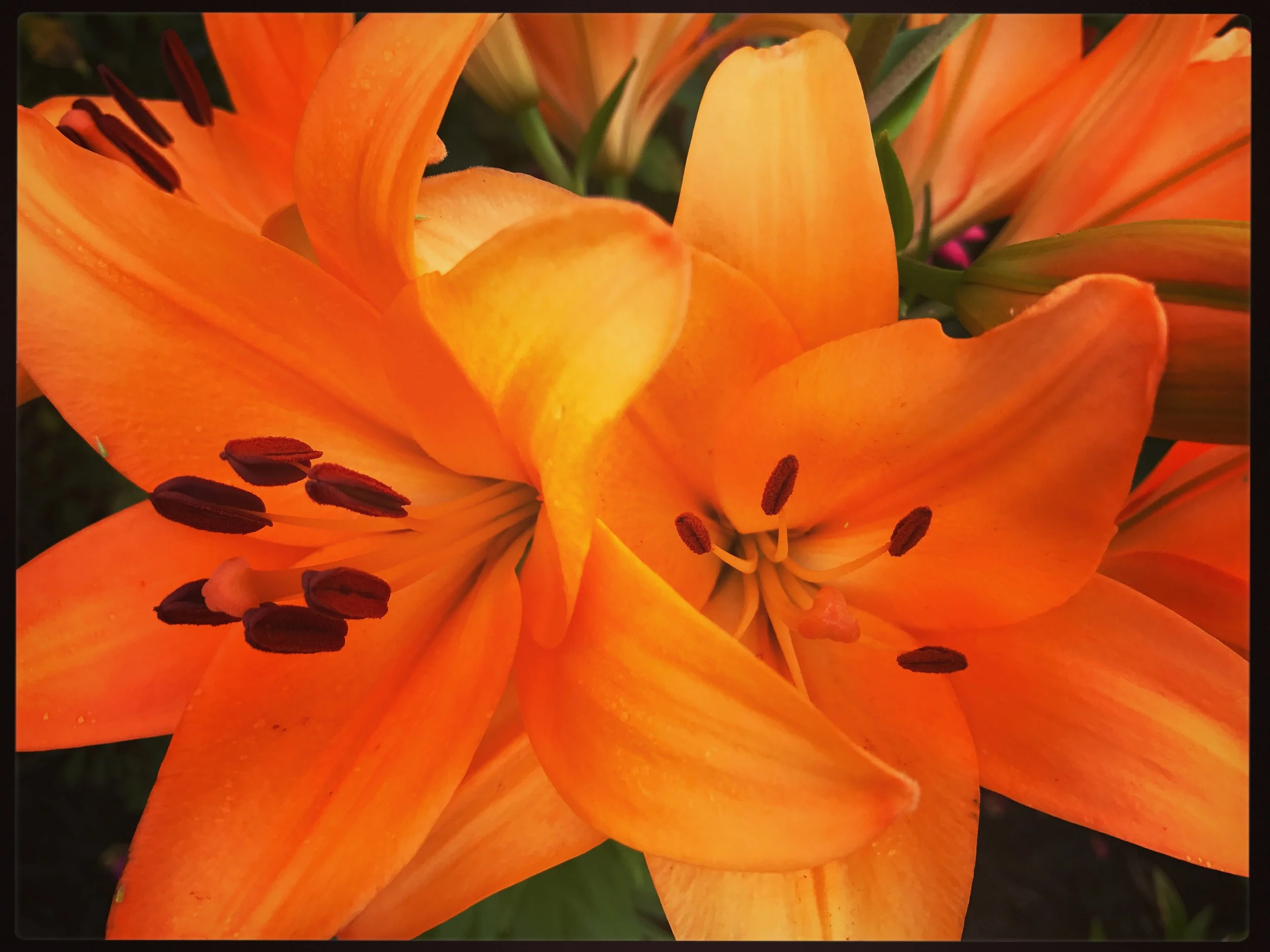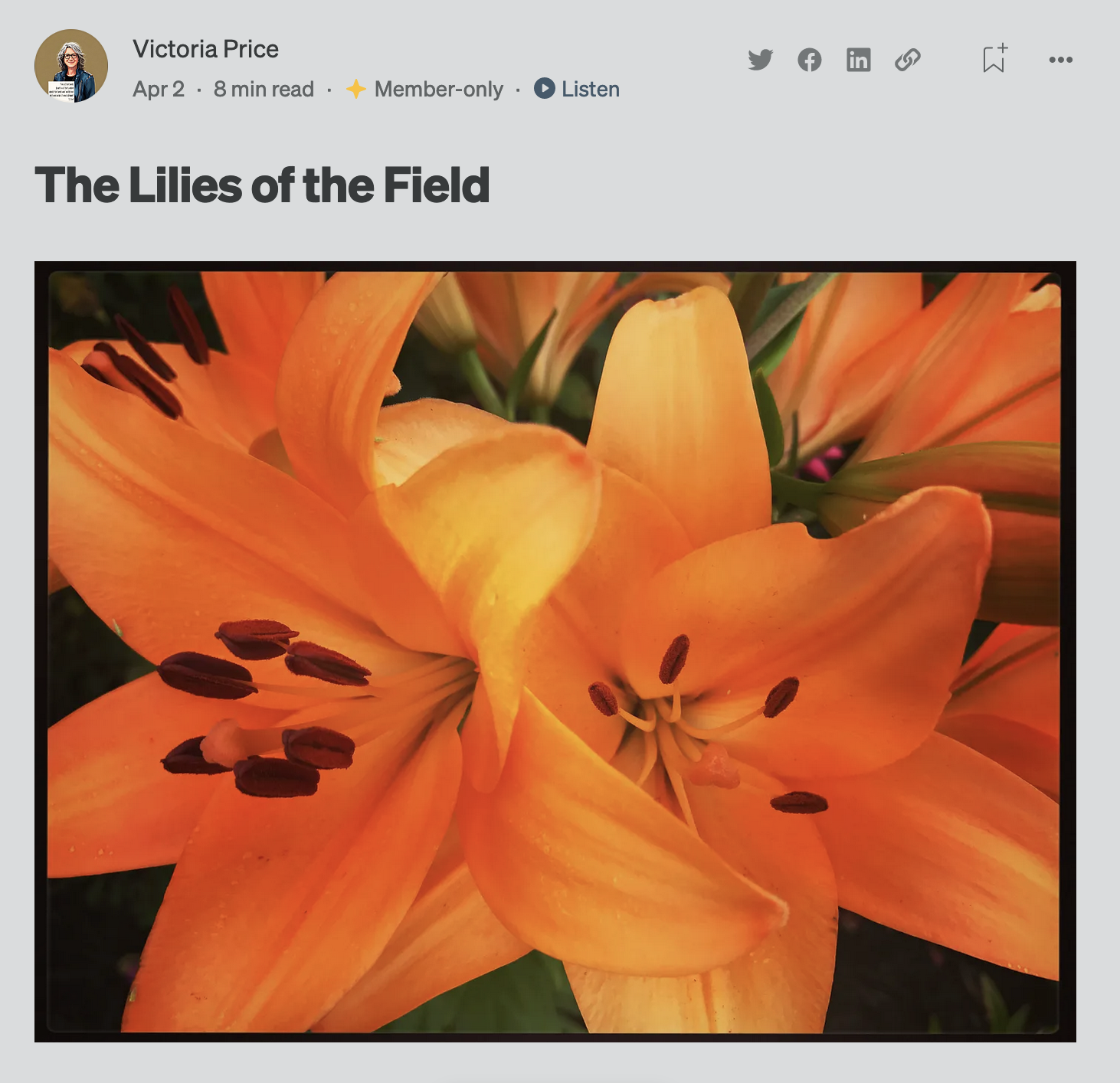
Consider the lilies of the field, how they grow, that they neither toil nor spin, yet not one influencer in all their glory will never be arrayed like one of them.
When I take a picture of a flower, a tree, a cloud, a meadow,
I am not comparing a rose to an iris, this oak to another I saw a few years ago.
I do not feel bad about myself because I am not as beautiful as a dahlia.
I do not think about how this lily or that lilac could look better.
Nor do I worry that I am invading a meadow’s privacy or that a maple may get bullied as a result of my actions.
Nor do I think my photograph is better than anyone else’s. It’s not.
It is usually taken with my phone while walking my dog who is trying to pull me to the nearest pole to pee.
But if someone posts a picture of me, all I see is what I dislike about myself.
If I see some beautiful influencer, all I feel is crappy.
And if I feel this way, imagine how young people feel.
What’s the difference?
Well, for a start, flowers don’t know we’re posting pictures of them,
and they’re certainly not posting pictures of themselves.
They are there to be our floral apostles of love and joy.
At least that’s how I feel when I spend time with them.
As the poet Mary Oliver wrote:
“When I am among the trees, especially the willows and the honey locust, equally the beech, the oaks and the pines, they give off such hints of gladness. I would almost say that they save me, and daily.”
That is EXACTLY how I feel.
Flowers and trees and meadows and clouds are not worried about their waistlines or their wrinkles
or their fragile egos or their uncertain futures. Of course, they’re not!
If any human ever felt as beautiful as a peony, as carefree as a cloud, as confident as a ponderosa pine,
as powerful as the tide, to what else could they possibly aspire?
Mary Oliver also wrote:
“My work is loving the world. Here the sunflowers, there the hummingbird — equal seekers of sweetness.”
At the moment I stop to really appreciate something I see on a walk,
that is what I am doing: loving the world.
But in that moment, miraculously, I am also loving myself.
So, what if I tried to capture in images and words
the grace of my interactions with nature,
and then shared that with others?
What if I helped remind people that it is possible
to stop being so focused on being seen
and instead focus on seeing all the beauty on this planet?
What if we all remembered to consider the lilies of the field, how they grow, that they neither toil nor spin,
yet not one influencer in all their glory will never be arrayed like one of them?
That’s what I’m doing these days on my social media, and also on this page.
Please let me know if the lilies and lilacs, the peonies and the hydrangea
(and mountain, meadows, birds, clouds, waves)
bring you as much joy as they bring me!
YOU CAN READ THIS WHOLE ESSAY ON MEDIUM
BY CLICKING THE PHOTO BELOW:
IMAGES & WORDS
I grew up in Hollywood, where the American myth of the white picket fence was propagated through shows like Father Knows Best and Leave It to Beaver. An imaginary all-white world where bad things never happened and families stayed together happily ever after. Ironically, the white picket fence itself began disappearing during this time. It seemed people preferred chain link — no paint necessary, and theoretically safer, especially if you added in a large barking dog.
I myself grew up behind high walls. At one point, we even lived with an armed security guard. My parents weren’t home much when I was a kid and got divorced after my father fell in love with his co-star. Maybe that was why I loved this one sweet yellow wood house just off the corner of Sunset and Beverly Glen which had a white picket fence. Whenever we drove past, I imagined that happy married parents and their kids and dogs who weren’t scared for their safety must live there.
Now that I live in a small town filled with white picket fences, I feel that old tug on my heart every time I see one. Except now I know my neighbors, and most of them really are happy. But I also know how hard they work on showing up to their own lives and each other and their neighbors. They have chosen to live in a place where being a good person and a good neighbor matters more than status, politics, or wealth. Every day they teach me how to live a more authentic, joyful and giving life. I am learning from them. . .as well as their white picket fences.
You see, the white picket fences here are usually covered in grey mildew or yellow pollen. If you touch one after three days of rain, they might fall apart in your hand. But still, if I see a flower in front of a white picket fence, I’ll take that photo every time. Why? Because together they are even more beautiful than by themselves.
The people here — and their white picket fences and their gardens filled with flowers — are not photoshopped or airbrushed. They themselves would tell you they are far from perfect. But what they have discovered is one of the great truths of life — one which this photo makes me feel: Together is better.
Yesterday my friend David emailed a photo he took of me at age 20. He's a great photographer, yet I hated everything about how I looked. Everything.
I cannot imagine being a young woman right now, believing you have to post selfies on social media every day. I'm honestly not sure I would have survived it.
I have been thinking a lot about how I held myself up to the Hollywood standards of beauty growing up, how I never ever once felt attractive enough.
Watching the publicity for Lana Wilson’s new documentary, Pretty Baby, brought this up for me big time.
Brooke Shields looked the way I thought I was supposed to look, and I'm ashamed to say
that I HATED her for it. When my dad put up a signed photo of Brooke
she had given him, I took it personally. Of course, I didn't let him
know that. Instead, I teased him. So, he teased me back by making that the only photo of ANYONE in the entire living room -- until the end of his life.
When Brooke got into Princeton, I hated her more. At least she could be stupid, so I'd have my intelligence to hold over
the imaginary Brooke with whom I bludgeoned myself.
But only now, seeing clips of this new documentary -- have I understood just how we all got played.
Lana shows us how Brooke was the pawn of patriarchy reacting to feminism -- sexualized, used, and diminished. God, how horrible that must have been for her.
But those of us who felt diminished by her beauty were also patriarchy's pawns. I see that now.
Yesterday, all I wanted was to cut myself out of David's photo.
So, I ran it through my photo editor, erased myself, and then asked AI to replace me with a black hole. AI made a different choice -- and nailed it.
This is exactly how I (and so many women) feel, when we believe that we need to look a certain way to feel good about ourselves.
Like distorted demented dolls.
But there is a silver lining: On Good Morning America, producer Ali Wentworth shared that making this film lifted Brooke's burden.
At last, she feels agency over her own life.
When I heard that, once again, I felt jealous. But not in a bad way this time.
If Brooke can find her way out, after all she's been through, we all can. I believe that now.
After my parents divorced, Easter became the holiday I always spent with my dad. This was our first one. It was 1974 and I was about to turn 12. My mom and I were living in an apartment, she was trying to get back on her feet, and it wasn’t easy for her that first year. She didn’t want anyone to know about her life as the former Mrs. Vincent Price as she began a new career in architectural design by remodeling a new house where we would eventually move. But it’s hard to hide a 6’4” movie star with one of the most recognizable voices on the planet — so we usually met my dad in the parking lot of a grocery store off the freeway. But that Easter he picked me up where we lived. And my mom did what she had always done — capture the moment on camera. I was so happy to be with my dad that I never thought about how hard it must have been for her to watch us drive away. But I did know how grateful I was that both of my parents remained friends and always wanted the best for each other and for me. (Which wasn’t always easy because of my stepmother.) I will always think of my dad on Easter, but this photo reminds me how grateful I am for the person who took all these pictures
of my dad and me — my mother. My dad taught me to see the joy in life. My mother taught me to capture it on film. Together they gave me what would become the daily practice of joy that has saved me over and over again. On this Passover and Easter weekend, I am filled with gratitude for their living Love.















